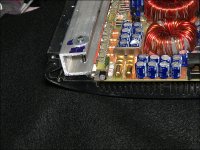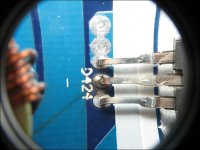While I am trying to sort some sense of this, listen to the sound I am talking about when I give the amp power:
YouTube - IMG_0480.MOV
Maybe you can identify some component from the sound like a transformer squeal or a transistor hiss or a capacitor. Dunno, but see what you think.
YouTube - IMG_0480.MOV
Maybe you can identify some component from the sound like a transformer squeal or a transistor hiss or a capacitor. Dunno, but see what you think.
If its a high pitched hiss/buzz from the transformer it is probably something on the output end clamping down/oscillating and backing up on the power supply. That video was so short it was practically useless, lol. Try making it a little longer 
And you might want to replace the arcing component if a terminal is broken or make sure its insulated from the sink as Perry mentioned. That can't be helping the situation.
And you might want to replace the arcing component if a terminal is broken or make sure its insulated from the sink as Perry mentioned. That can't be helping the situation.
Last edited:
Well here's the arching:
YouTube - IMG_0483.MOV
and the sound again (as posted above)
http://www.youtube.com/watch?v=VJleOOVmSJI
I'm not leaving this thing latched any longer with this arching going on so listen close. It's the sound I am hearing, long or short.
EDIT: this is with no load by the way. Just the amp and power.
YouTube - IMG_0483.MOV
and the sound again (as posted above)
http://www.youtube.com/watch?v=VJleOOVmSJI
I'm not leaving this thing latched any longer with this arching going on so listen close. It's the sound I am hearing, long or short.
EDIT: this is with no load by the way. Just the amp and power.
Last edited:
That is probably a tiny piece of metal between the insulator of that transistor and it is grounding the case of the transistor to the sink, not good at all. Usually pieces of the metal that come from the bottom plate screw holes (right next to that transistor) get under the transistors and cause that. Sometimes a bur on the transistor can also poke through the insulator. Make sure to check under it and clean and re-grease. There is also a possibility one of the legs is touching the sink under the circuit board, you can look from one end with an end cap off to check. Also don't power the amp up without the bottom plate on, the art series will smoke a transistor in a second if you do that. If they're not clamped down the output transistors will individually get different temperatures, change values, and then can oscillate as well sometimes causing self destruction.
Remember... Don't power the amp up with the bottom cover off
Remember... Don't power the amp up with the bottom cover off
Last edited:
Hell I've ran it without the bottom case before with music (not this a600, but another). Long as you don't load it up and go plowing through anything it does ok so long as the transistors are all mounted down flat. If any are floating in the air or you're loading it up with a lot of juice you got problems! The amp must run to be diagnosed. it will at least do that, idle, if nothing else. However yes I had ran a few 600's without the bottom for 3 minute stretches playing music. They do fine at low volume.
This one however won't even turn on right now with this issue.
This one however won't even turn on right now with this issue.
Got the mobo back out, this one is arching at the connections from Q1 to the mobo on bottom where soldered in. There are some indicators the arching is grounding itself to the amp shell as there is a light brown streak. Nothing like a real arch however where there would be an obvious point of grounding, but some indication the arch is riding the shell.
That's very odd because the amp was actually playing along just fine for a few minutes.
After about 2 minutes it started doing this. Nothing changed between the time it was NOT arching and the time it began arching. Something must be causing this, I bet it is CR1 right beside it. FENI6DT is cr1's part number. Maybe? I dunno at this point. I am stumped.
An externally hosted image should be here but it was not working when we last tested it.
That's very odd because the amp was actually playing along just fine for a few minutes.
After about 2 minutes it started doing this. Nothing changed between the time it was NOT arching and the time it began arching. Something must be causing this, I bet it is CR1 right beside it. FENI6DT is cr1's part number. Maybe? I dunno at this point. I am stumped.
Last edited:
You may need build some clamps like the ones shown in the attached photo. They only take about 10 minutes to make. With the clamps, you can play the amp as long as needed to troubleshoot.
The brown streaks are from the material that was burning off at the intermittent connection. See second photo for another example of streaking.
The brown streaks are from the material that was burning off at the intermittent connection. See second photo for another example of streaking.
Attachments
I've already pulled all the drivers twice unfortunately. It seems to be arching from leg to leg and that spot on the case is directly under the arching. It doesn't seem to have a grounding spot so it looks like it is just being flashed by the legs arching. Why would the legs be arching all of a sudden if the amp was previously playing.
Q1 is the one I said looked like it had heat on it previously before all this started.
Q1 is the one I said looked like it had heat on it previously before all this started.
Last edited:
There is not enough voltage in the amp to arc, that is a SPARK from something having an intermittent connection, either the solder points on the transistor are faulty, one of the legs is cracked, or one or more of the legs are touching the sink. An arc is when the voltage is so high it jumps from one point to another. And yes, the amp can easily fail without the transistors bolted down. You would be extremely lucky to have one run even a minute without the bottom cover.
With the board out of the heatsink, the amp on and looking at the bottom of the board, move Q1. Do you see any arcing?
So you want me to put power to it and test it like this:
An externally hosted image should be here but it was not working when we last tested it.
PPIA600, this amp wasn't this clean from the factory. It doesn't get any better than this. everything triple soldered, and SPOTLESS. I don't know what the amp is doing or I wouldn't be asking for help (which I am very grateful for), but I know what it's not doing.
An externally hosted image should be here but it was not working when we last tested it.
Ok guys here ya go. I've tested these connections with a DMM on top and bottom, I've soldered them ten times, the amp is clean enough to eat off of. Here is the arcing of the Q1 from underneath. The arc happens at the 7 second mark.
http://s32.photobucket.com/albums/d5/audiogodz1/?action=view¤t=FILE0001.flv
It is arcing between leg 2 and 3.
PPIA600, as much as I appreciate your help I need correct information. I have slowed the video down in slow motion and watched the arc jump from leg to leg. Unless I'm going nuts, the video shows an arc between the legs and is completely convincing in slow motion. Also confirming the evidence I found earlier on the heat sink that the heat sink looked scorched, not like it was the intended target of the arc.
Here is the slow motion in picture form.
http://s32.photobucket.com/albums/d5/audiogodz1/?action=view¤t=FILE0001.flv
It is arcing between leg 2 and 3.
PPIA600, as much as I appreciate your help I need correct information. I have slowed the video down in slow motion and watched the arc jump from leg to leg. Unless I'm going nuts, the video shows an arc between the legs and is completely convincing in slow motion. Also confirming the evidence I found earlier on the heat sink that the heat sink looked scorched, not like it was the intended target of the arc.
Here is the slow motion in picture form.
An externally hosted image should be here but it was not working when we last tested it.
An externally hosted image should be here but it was not working when we last tested it.
An externally hosted image should be here but it was not working when we last tested it.
An externally hosted image should be here but it was not working when we last tested it.
Last edited:
An externally hosted image should be here but it was not working when we last tested it.
I can't see a jump,(couldn't slow the vid) it appears it is conducting there and burning the fiberglass board. Remove that transistor and read between pins 2 and 3. It takes thousands of volts to create an arc, the amp doesn't create enough even with the total bridged power supply voltage. The only other way to create an arc in a similar circuit would be to have an intermittent shorting contact, a lot of current and a high resistance/wind coil all in series, kind of like when you apply voltage to a relay coil and then remove it but a relay has a high enough wind count to create high voltage when the magnetic field collapses after removing voltage.
Unless Perry can give another explanation for creating arc level voltage that is all I can figure.
Unless Perry can give another explanation for creating arc level voltage that is all I can figure.
Last edited:
Pins 2 and 3 wouldn't actually supposed to be connected there by any chance and it has burned through the jumper and is arching? I can't find any evidence to support those two pins are supposed to be tied together, but that's all I can figure. The fiberglass is burned in that area, but I was thinking it was because the jumper failed and started arching? They are not connected to each other electrically at all with that transistor out of the circuit. Man I really need a schematic for this amp.... or another a600 to look at. I bet those two pins jump to each other and the jumper has arched off.
Last edited:
Its not the same exact amp, but keep an open mind. It uses pretty much the same circuitry just a stronger power supply. I've owned a600's as well, they are shorter and have the same tubes cut through the sink to allow for liquid cooling. Both are great amps.
Mine measures 5k between 2 and 3 with it in circuit. Let me double check to be sure I'm measuring the same one.
Mine measures 5k between 2 and 3 with it in circuit. Let me double check to be sure I'm measuring the same one.
- Status
- This old topic is closed. If you want to reopen this topic, contact a moderator using the "Report Post" button.
- Home
- General Interest
- Car Audio
- PPI Art 600 R121 ..... what ohm is it????

